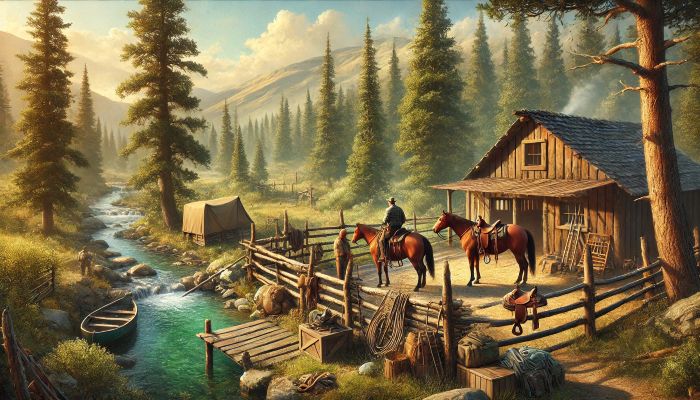Last Updated on February 23, 2025 by Teri Rehkopf
Backcountry survival takes on a whole new meaning when you prepare not only for yourself but also for your horse. Exploring the rugged outdoors demands careful planning and gear selection to navigate beauty and unpredictability safely.
In this guide, I share detailed insights and practical tips every horse owner should consider before setting off on extended trips into remote areas.
Every backcountry adventure requires thorough preparation to guarantee both your safety and that of your horse. Before setting out, create a detailed equipment checklist covering items for both human and equine needs.
Your gear should include:
- a robust all-in-one first aid kit with supplies for minor injuries,
- durable saddles,
- a dependable lead rope or two,
- extra blankets,
- and a portable tool kit for on-the-spot repairs.
Additional essential items include:
- high-energy snacks,
- extra feed for your horse,
- and emergency communication devices such as:
- a satellite phone
- or radio.
- a GPS device,
- high-quality halters,
- reflective gear,
- and emergency markers.
Packing the right equipment not only offers peace of mind but also minimizes the risk of unexpected delays when you are far from help.
Navigating the Wilderness: Map Reading and Compass Skills for Equestrians
Mastering traditional navigation techniques is very important when exploring vast natural landscapes. Even though modern gadgets like handheld GPS units are useful, it is vital that you keep a paper map with marked trails and points of interest along with a reliable compass. This ensures that you’re never completely lost if your technology fails.
Essential Gear for Backcountry Survival: A Guide for Horse Owners
Practice these navigation skills under routine conditions so that you feel comfortable when you face the challenges of backcountry travel. Focus on natural landmarks such as streams, hills, and valleys, and compare these features to your map. Teach your horse how to behave during turns and stops, and take time to check trail indicators regularly for a safe and enjoyable journey.

Horse First Aid: Tackling Emergencies in Remote Locations
No amount of planning can prevent all accidents. A well-stocked first aid kit designed for both you and your horse is essential on any backcountry trip.
Ensure you include:
- bandages,
- antiseptics,
- adhesive tape,
- pain relievers,
- and, if necessary, hard copies of first aid manuals.
For equine emergencies:
- pack wound disinfectant,
- vet wrap,
- and a small assortment of equine medications to address minor issues until professional help is available.
If you are not experienced with emergency care, consider attending a basic first aid course tailored for horse emergencies. Being prepared to manage situations like:
- cuts,
- dehydration,
- and muscle strains can make a critical difference.
The more prepared you are, the faster you can respond to unexpected injuries.
Sustainable Foraging: Identifying Safe Plant Edibles for You and Your Horse
Backcountry trips offer an opportunity to experience nature and learn about sustainable foraging. Knowing which wild berries, herbs, and grasses are safe for both you and your horse can add to your adventure.
Perform thorough research or seek local experts’ advice before consuming wild plants. Even typically safe edibles should be consumed in moderation to avoid upsetting your horse’s digestive system.
Keep a record of any edible plants you identify and note their seasonal availability. This practice helps you decide when foraged foods can safely complement your diet. Maintaining caution and verifying plant edibility will contribute to a balanced and exciting backcountry meal plan.
Water Sourcing Tips: Hydration Solutions in the Backcountry
Finding safe water is a crucial part of ensuring a successful backcountry adventure. Natural water sources such as streams, springs, and rainwater can be excellent, but water safety should never be taken for granted.
Always treat any water collected from the wild to remove harmful contaminants by using filters, purifying tablets, or portable boiling kits.
Before filling your containers, take a moment to assess the water source’s quality. Research local water safety or ask experienced locals about potential hazards in the area.
Keeping you and your horse well hydrated is really important, and using proper purification techniques is the key to avoiding waterborne illnesses.
Camp Setup: Creating a Safe Haven for You and Your Horse
Setting up camp involves more than merely pitching a tent. The goal is to create a secure and comfortable living space for both you and your horse. Choose a campsite that offers natural protection from wind and wildlife.
Ideally, the site should have flat ground free from hazards like sharp rocks or uneven terrain, and it should be situated a safe distance from water bodies unless you’re confident of safe access.
Arrange makeshift pens or temporary barriers to keep your horse secure. Natural elements, such as clearings with dense thickets, can provide shade on hot days or wind protection during cold nights.
To maintain safety and order during your trip, divide your camp area into sections for:
- cooking,
- resting,
- and stabling.
Weathering the Elements: Protective Measures for Horses in the Great Outdoors
Backcountry weather can change rapidly and behave unpredictably. Protecting your horse in cold and hot conditions is very important.
Cold weather may require:
- horse blankets,
- waterproof gear,
- and windbreaks to prevent your horse from catching a chill.
Similarly, having shaded areas where your horse can cool off is vital in warmer weather.
- When temperatures rise, utilize portable fans, tarps, or other creative cooling solutions.
- Regularly monitor your horse’s water consumption.
- Ensure its path is free of debris and mud to prevent slips.
- Consistent monitoring and planning for extreme weather conditions ensure that both you and your horse remain safe throughout your adventure.
Trail Obstacles and Solutions: Tackling Natural Barriers with Your Horse
The backcountry is invariably full of natural obstacles, from rocky patches to steep inclines and dense brush. It is important to plan your route in advance by studying topographical maps to help identify these challenges.
- A well-prepared approach lets you choose alternate paths or adjust your riding style based on the terrain.
- Slow down when you encounter difficult sections and give clear signals to your horse.
- Before proceeding, pause to assess the safest way to cross obstacles, such as shallow streams or uneven ground.
- Regularly taking short breaks to rest and realign ensures that you and your horse safely navigate the terrain.
DIY Horse Shelter: Building Temporary Structures in the Wild
A DIY horse shelter can offer vital protection from the elements when developed facilities are far away. A simple shelter does not need to be elaborate; a portable tarp with a basic frame can create an effective stopover during sudden weather changes. Natural materials like branches and leaves can further support the structure.
Focus on low-impact designs that do not disturb the natural landscape significantly. Key considerations include proper drainage to avoid water pooling and frequent shelter stability checks.
Reinforcing your shelter with:
- rocks
- or weights
- and taking advantage of natural wind barriers, you can create a safe, temporary haven.
Communicating in Crisis: Using Technology and Signals in Remote Areas
Reliable communication is essential when venturing into remote areas. Since cell service may be unreliable, pack alternative devices like:
- a satellite phone (best option),
- personal locator beacon,
- or emergency radio in your pack.
These tools can serve as lifelines during crises.
In addition to modern devices, traditional signaling methods such as:
- whistles,
- flares,
- and reflective mirrors remain effective.
Practice using these tools, and make sure both you and your horse remain calm in emergencies. Always inform someone about your planned route and expected return time to help rescuers if necessary.
Wrapping Up
Exploring the backcountry with your horse isn’t just about overcoming challenges. It is also about deepening the connection between you and your animal. Proper planning turns each ride into an opportunity for growth, learning, and mutual trust.
Detailed preparation in gear selection, navigation, first aid, and shelter construction creates a rewarding and safe experience.
Frequently Asked Questions
Question: What is the most important piece of gear for backcountry horse survival?
Answer: An all-in-one kit that covers both human and equine needs is key. Be sure to pack first aid supplies, reliable navigation tools, purification methods for water, and equine-specific care items.
Question: How can I ensure my horse stays safe during extreme weather?
Answer: Investing in quality protective gear such as horse blankets and ensuring ample shade can help. Regular monitoring of your horse’s condition during temperature extremes is really important for its well-being.
Question: What are the best practices for setting up a camp?
Answer: Choose a secure site with natural barriers and flat terrain. Organize your space with designated sections for cooking, sleeping, and stabling your horse for an orderly setup.
Question: Which communication tools are the most reliable in remote areas?
Answer: Satellite phones and locator beacons are very important. Traditional tools, including whistles and flares, provide additional support if modern devices fail.
Gear up, stay prepared, and trust your instincts. The backcountry offers both incredible beauty and challenging conditions. With every careful step, you and your horse can enjoy a rich, rewarding adventure that not only tests your skills but also builds a lasting bond.
Remember that every journey in the backcountry is unique. The lessons you learn on the trail—from reading the subtle signs of nature to managing unexpected events—are invaluable. Each experience strengthens your confidence and prepares you for future challenges.
Embrace the unpredictability of the wilderness, and always strive to improve your survival skills. With thoughtful foresight and deliberate preparation, adventure becomes not only safe but also tremendously fulfilling.

